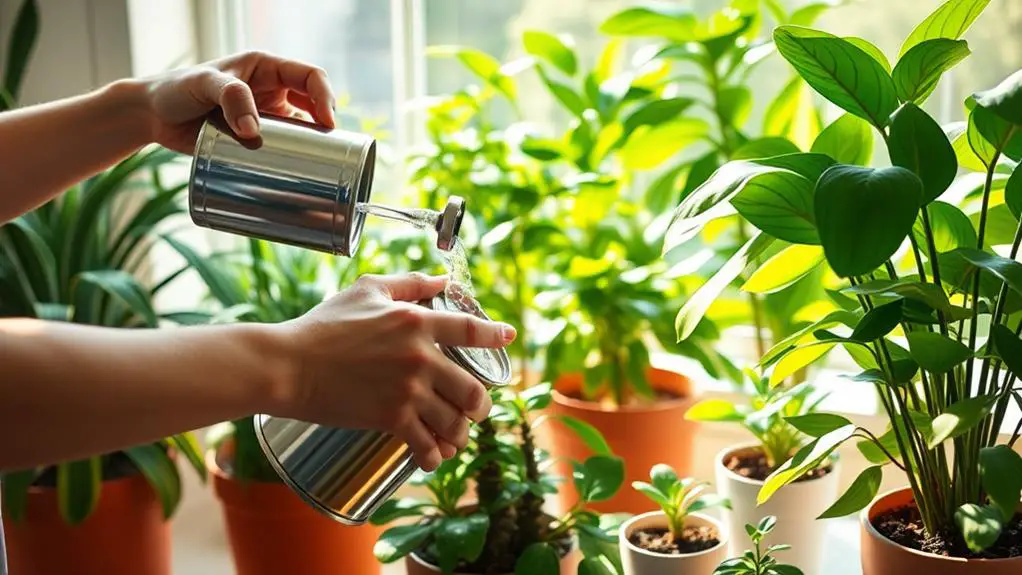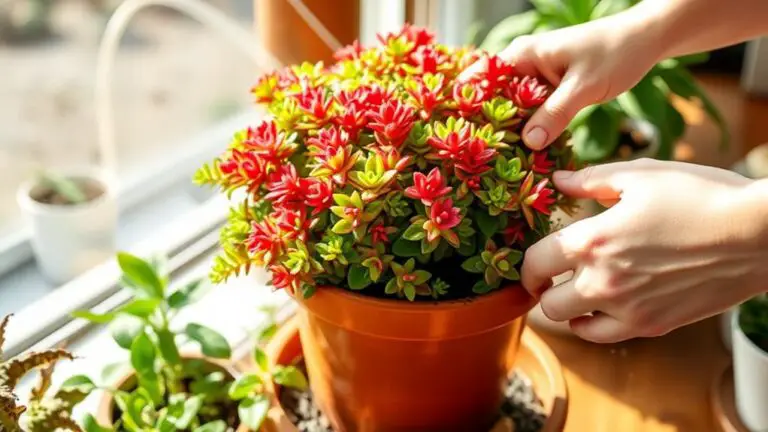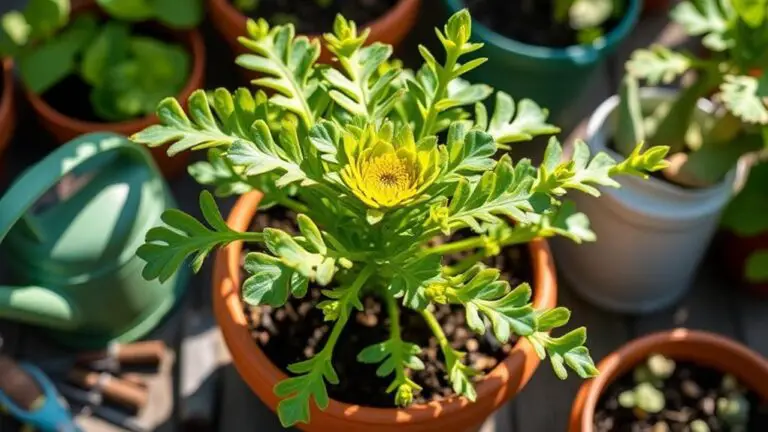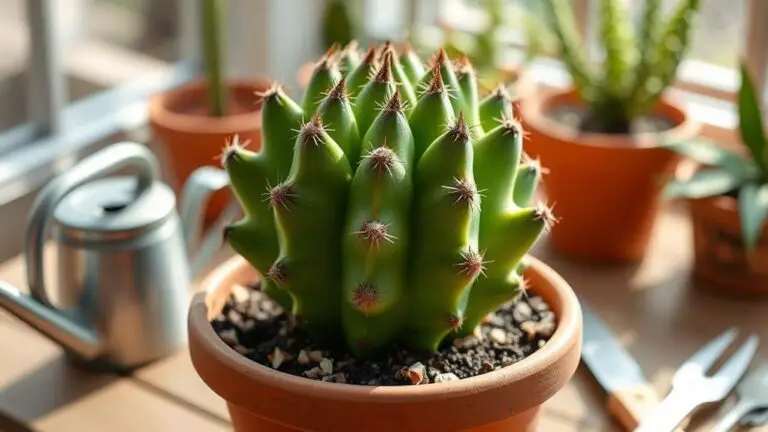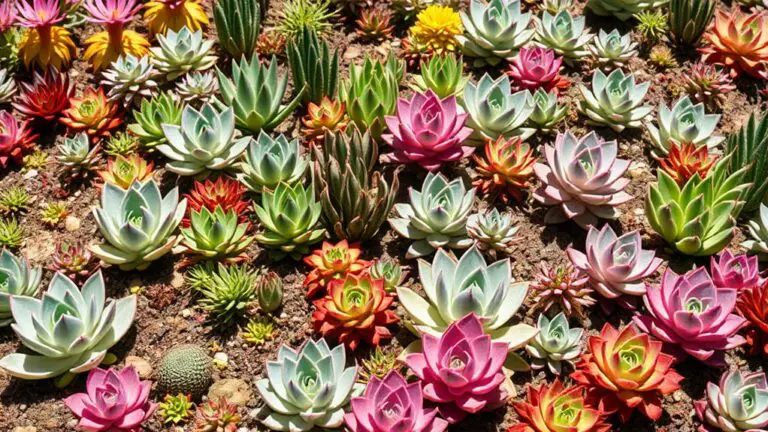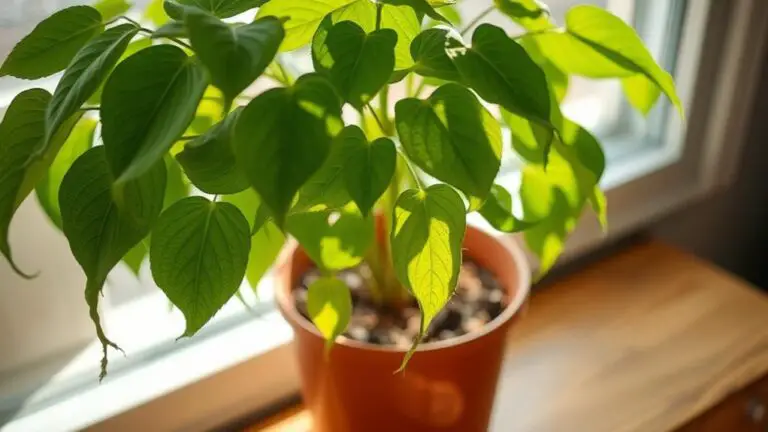Top 7 Watering Tips to Help Your Houseplants Thrive
Ensuring your houseplants thrive starts with mastering the art of watering. You might think it's as simple as pouring water into a pot, but there's much more to take into account. From using the right type of water to timing your watering sessions, each step plays a vital role. Do you know that watering in the morning can greatly boost photosynthesis? Or that the amount of water you use should change with the seasons? By focusing on these details, you'll see a noticeable difference in your plants' health and growth. Curious about the specific techniques? Let's explore them together.
Use the Right Water
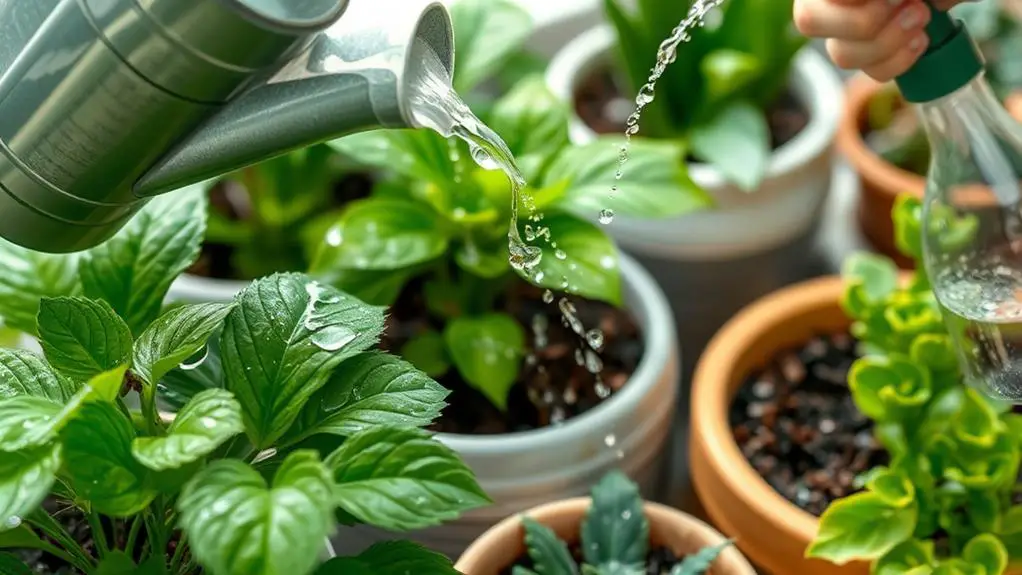
When it comes to watering your houseplants, using the right water is essential for their health. Distilled water is a great choice, especially for sensitive houseplants. It's free from minerals and chemicals that could harm their roots, keeping them healthy and happy.
Room temperature water is also important. If water is too cold or too hot, it can shock the roots, making it harder for your plants to absorb nutrients effectively.
Be cautious with hard water. While it's safe in small amounts, hard water contains minerals that can build up in the soil over time, potentially causing problems for your plants. To avoid this, try to use hard water sparingly.
On the other hand, soft water, which often has high salt content, should be avoided for regular watering. Consistent use of soft water can damage your plants over time.
It's a good idea to regularly check the quality of your watering source. Tap water, for example, can sometimes have high salt levels that aren't good for your plants.
Measure Water Amounts
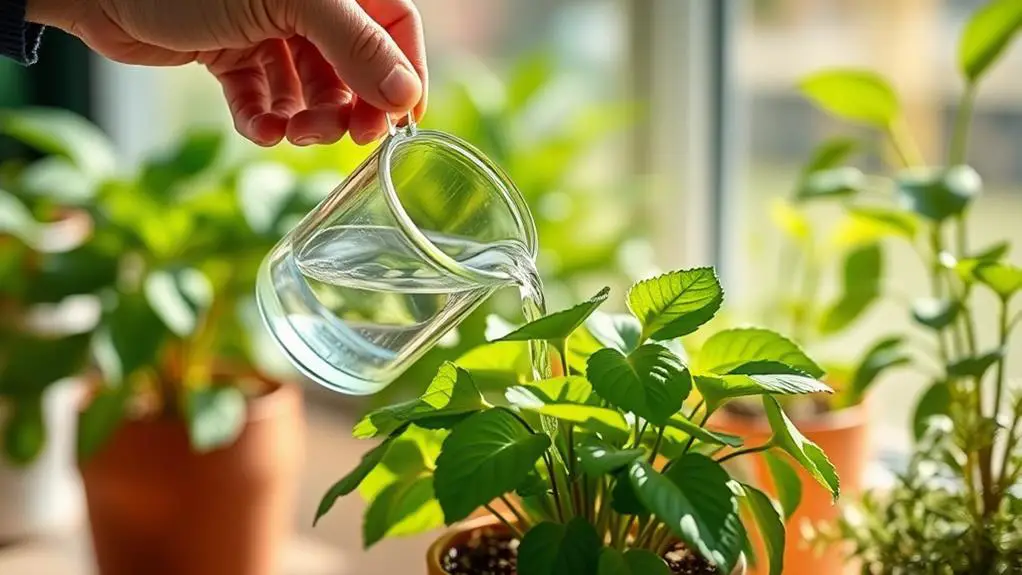
To make sure your plants stay happy and healthy, you need to measure their water amounts carefully.
First, check the soil moisture by inserting your finger about 2 inches deep; if it feels dry, it's time to water.
Check Soil Moisture
It's important to regularly check soil moisture to guarantee your houseplants thrive. To do this, simply insert your finger at least an inch deep into the soil. If it feels dry, then it's time to water your plants. On the other hand, if the soil sticks to your finger, it means there's adequate moisture and you can wait before watering again.
For a more precise measurement, especially with larger pots, you can use moisture meters. These handy tools provide accurate readings of soil moisture content, helping you better understand when to water your plants.
Remember, different environmental conditions and plant types can affect how often you need to check soil moisture. Make it a habit to assess moisture levels regularly.
Signs of underwatering, like slow growth, brittle leaves, or soil pulling away from the edges of the pot, should prompt an immediate check. If you notice any of these symptoms, it's likely time to water your plants.
Adjust Seasonal Watering
Seasonal watering adjustments are essential for maintaining healthy houseplants throughout the year. During the winter months, you'll notice your indoor plants need less water. This is because lower evaporation rates and plant dormancy mean less frequent hydration is necessary. Check your plants every 2-3 weeks to see if they need water.
As temperatures rise in spring and summer, adjust your watering schedule accordingly. Warmer weather and increased evaporation mean your plants will likely need water more often. For many plants, weekly watering is enough, but during extreme heat, daily checks might be necessary. Keep an eye on the soil's dryness to guide your plant care.
Environmental factors like humidity and temperature can also affect how quickly the soil dries out. Humid conditions might mean less frequent watering, while dry, hot weather can require more.
Larger plants and pots generally retain moisture longer than smaller ones, so tailor your watering schedule to fit the size of your plants and their containers.
Monitor seasonal changes closely. Spring often brings new growth, so up your watering game to support it. Conversely, as fall approaches, gradually reduce watering as plants prepare for dormancy.
Research Plant Needs
Understanding how to adjust seasonal watering schedules is just one piece of the puzzle in plant care. To truly help your houseplants thrive, you need to research plant needs and understand their specific watering requirements. Every plant is unique. For instance, succulents need much less water than tropical plants, which prefer consistently moist soil.
Environmental factors like sunlight and temperature also influence watering needs. Brighter and warmer conditions typically mean your plants will need more water. Before you start watering, it's essential to research the specific needs of each plant species. This helps prevent over or underwatering, which can stunt growth or harm your plants.
Soil composition is another key factor. Heavier soils retain water longer, meaning less frequent watering is needed compared to lighter, porous soils. Seasonal changes also play a role; plants usually need more water during active growth in spring and summer than in the dormant winter months.
Here's a quick reference table to help you:
| Plant Type | Watering Needs | Soil Type |
|---|---|---|
| Succulents | Low | Light, porous |
| Tropical | High | Moist, rich |
| Ferns | Moderate | Well-draining |
Time Your Watering
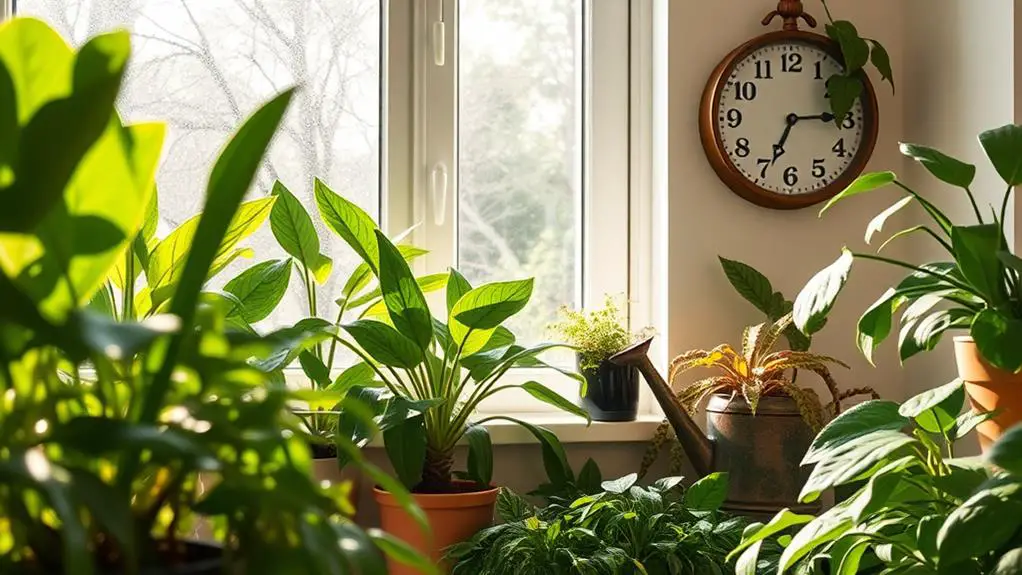
Timing your watering can make a big difference for your houseplants' health.
Watering early in the morning helps them get ready for the day, supporting photosynthesis and letting any extra water on the leaves dry up.
Avoid evening watering to prevent issues like mold and fungal diseases, which thrive in damp conditions overnight.
Ideal Morning Routine
Starting your day by watering houseplants in the early morning guarantees they can absorb moisture before the heat of the day increases evaporation rates.
Watering plants at this time supports photosynthesis, as they can use the water throughout the day for best growth. Plus, watering in the morning helps excess moisture on leaves to dry out, reducing the risk of mold and fungal diseases.
Establishing a consistent morning watering routine can lead to healthier plants by aligning with their natural biological rhythms. This habit allows you to catch any potential issues early, such as pests or wilting, providing a better chance to address them promptly.
Here are some tips to enhance your morning watering routine:
- Use lukewarm water: Cold water can shock plants, while too hot can damage roots.
- Check soil moisture: Stick your finger an inch into the soil to see if it's dry before watering.
- Water at the base: Aim to water the soil directly to avoid wetting the leaves.
- Be consistent: Try to water at the same time each morning.
- Watch for excess water: Confirm pots have drainage holes to prevent root rot.
Avoid Evening Watering
While a morning watering routine is beneficial, it's equally important to avoid watering your houseplants in the evening. Evening watering can leave your plants with prolonged moisture on their leaves, increasing the risk of mold and fungal diseases. This is especially true in areas with high humidity. When you water your plants every morning, they can absorb the moisture they need during the day when photosynthesis occurs, promoting healthier growth.
Morning watering also guarantees that any excess water on the leaves has time to dry. This reduces the chance of leaf scorch and disease. Additionally, watering in the morning helps you establish a consistent routine, making it easier to monitor your plants' health and moisture needs. By avoiding evening watering, you prevent temperature fluctuations that can stress your plants due to nighttime cooling and humidity changes.
Here's a quick comparison to understand better:
| Time of Day | Benefits | Risks |
|---|---|---|
| Morning | Absorption, Routine | Few risks |
| Afternoon | Absorption, Drying | Moderate evaporation |
| Evening | None | Mold, Fungal diseases |
| Night | None | High risk of diseases |
Master Watering Techniques

To master watering techniques for houseplants, guarantee you're applying water evenly around the soil mass so all roots get the moisture they need.
Start by making certain the soil is moist throughout and not just in one spot. This prevents uneven hydration, which can harm your plants. Use room temperature water to avoid shocking the roots. This helps the plants absorb water efficiently.
Here are some tips to help you perfect your watering skills:
- Use long-necked watering cans: These are great for reaching hanging plants and avoiding spills.
- Top water instead of bottom water: This guarantees even distribution and prevents salt buildup.
- Employ moisture meters: They're especially useful for larger pots to measure soil moisture accurately.
- Let excess water drain: This avoids waterlogging and root rot, which can damage your plants.
- Check the soil first: Always test the soil before watering to see if your plants need watering.
Monitor Soil Moisture

Monitoring soil moisture is essential for maintaining the health of your houseplants. To accurately monitor soil moisture, start by using your finger to check the soil. Insert it at least an inch deep. If the soil sticks to your finger, it means there's enough moisture. If it's dry, it's time to water your plants. This simple method can help you avoid common watering mistakes.
For more precise readings, especially in larger pots, consider using a moisture meter. These handy tools can give you a clear idea of the soil's moisture content, helping you avoid both over and underwatering. Remember, consistent monitoring of soil moisture establishes a good routine and promotes healthier growth.
Look for signs that indicate overwatering, like wilting leaves, yellowing, or brown tips on new growth. On the other hand, underwatering often results in slow growth, brittle leaves, and soil pulling away from the planter sides.
A good rule of thumb is to let the top 2 inches of soil dry out before watering your houseplants again.
Avoid Common Mistakes

Avoiding common mistakes in watering houseplants can greatly enhance their health and longevity. One of the most common errors is overwatering, which can lead to root rot. You might notice wilting, yellow leaves, or soggy soil. To prevent this, always check the moisture level before adding more water.
Underwatering, on the other hand, can cause the soil to pull away from the pot edges and result in wrinkled leaves. Regularly monitoring soil moisture is vital, especially for smaller pots that dry out quickly.
Creating a consistent watering schedule tailored to each plant's specific needs can help you avoid these pitfalls. Researching individual plant care is essential for ideal hydration.
Here are some practical tips to help you:
- Check the soil moisture level before watering to confirm it's needed.
- Avoid overwatering by letting the top inch of soil dry out between waterings.
- Prevent underwatering by keeping an eye on soil that pulls away from the pot edges.
- Use room temperature water to prevent root shock.
- Observe plant health regularly to catch any watering issues early.
Adjust for Seasonal Changes
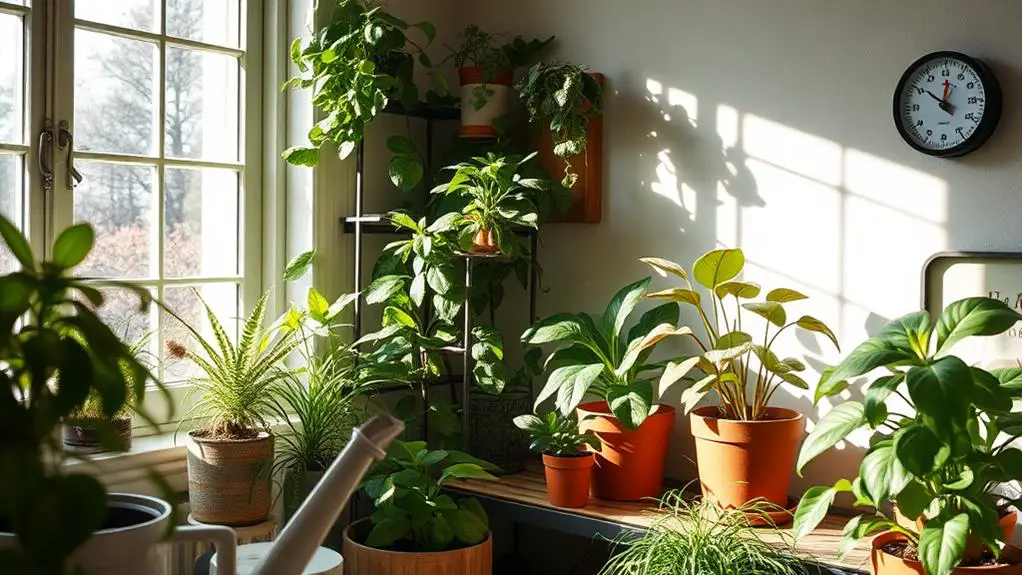
As the seasons change, your houseplants' watering needs will vary, and being attentive to these shifts is essential for their well-being.
During the winter months, plants need less water since lower evaporation rates and dormancy reduce their water requirements. Check soil moisture more frequently to avoid overwatering. Simply stick your finger into the soil up to the first knuckle; if it feels dry, it's time to water.
When spring arrives and temperatures rise, you'll notice your plants waking up and growing more actively. With increased daylight, they may need weekly watering to support new growth and blooming.
As you head into late spring and summer, hot weather can make soil dry out quickly, especially in smaller pots or hanging plants. This might mean daily or multiple waterings per week.
Frequently Asked Questions
How Do I Make My Indoor Plants Thrive?
To make your indoor plants thrive, use room temperature water, check soil moisture regularly, water in the early morning, and adapt your watering technique and schedule to the seasons. This approach guarantees ideal hydration and plant health.
What Are the 7 Important Things to Consider in Growing an Indoor Plant?
Consider light requirements, watering practices, humidity levels, soil moisture checks, seasonal adjustments, pot drainage, and proper fertilization. Focus on each plant's specific needs to guarantee it thrives in your indoor environment. Don't forget regular monitoring!
What Is the Best Way to Water Indoor Plants?
The best way to water indoor plants is to check the soil moisture by inserting your finger an inch deep. If it feels dry, water evenly with room temperature water, ideally in the early morning to support photosynthesis.
What Are Some Hacks for Watering Houseplants?
Use a moisture meter to prevent overwatering. Bottom water sensitive plants by placing pots in a tray of water. Employ self-watering spikes during vacations. Group similar plants together for easier care and consistent moisture levels.
Conclusion
You've got everything you need to keep your houseplants happy and healthy! By using the right water, measuring amounts, timing your watering, mastering techniques, monitoring soil moisture, avoiding common mistakes, and adjusting for seasons, you'll see your plants thrive. Remember, each plant is unique, so don't hesitate to research their specific needs. You've got this! With a little practice and attention, your indoor garden will flourish beautifully. Happy gardening!

